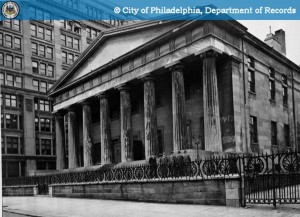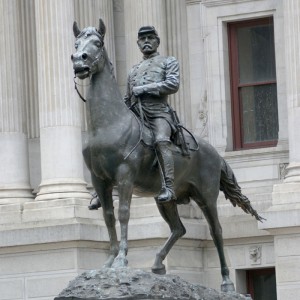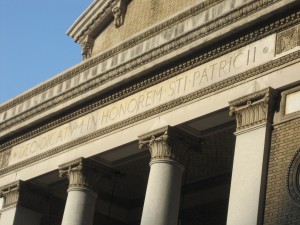On a recent visit to Monument Lab, the public art project and installation in City Hall’s courtyard, I realized that Classicizing Philadelphia faces a problem. This project imagines classical reception as a long conversation with Greece and Rome. Documenting and studying that conversation in Philadelphia are two important pieces of Classicizing Philadelphia’s mission. Continuing the conversation is a third goal, no less important than the first two. Monument Lab ought to be a natural venue for engaging Philadelphians in that conversation, and for listening to our ideas on it. What could be more monumental than Greece and Rome? What vocabulary has been more natural to monument-making than classical architecture, or bronze statues, or marble inscribed with classical languages?
That’s just the problem. Few people engage the classical world in conversation any more. Classicism and its monuments seem to reflect the values and monuments of an elite. The conversation with Greece and Rome belongs, it seems, to the past, and to the people who imagined the Second Bank, or the statue of McClellan next to City Hall, or the Latin inscriptions that are in every sense over people’s heads on Philadelphia streets.
Monument Lab invites a different kind of dialogue: what do we want to say about who we are now? As their guiding question puts it, “What is an appropriate monument for the current city of Philadelphia?” When I visited Monument Lab, the poet Tom Devaney invited us to look at City Hall’s columned, pedimented façade. Underneath that veneer, he reminded us, were hundreds of thousands of bricks, each one made by someone. (He has good ideas about bricks.) A monument for 21st century Philadelphia, he suggested, should look beneath the classical veneer to the core underneath, and the work of the people who made it. The current city of Philadelphia wants to remember itself as a city made not only by a classically minded elite, but also by the people who made the bricks in City Hall.
Yet Philadelphia has a tradition of vernacular classicism. The people who made the bricks have been part of the conversation with Greece and Rome. In my next post, I hope to say something about their part of the conversation. In the meantime, I’ll be back at Monument Lab. Don’t miss it in City Hall courtyard until June 7.
-
Pingback from Conceptualizing new monuments | Tom Shakely on June 3, 2015 at 1:56 pm
Comments are now closed.




1 comment